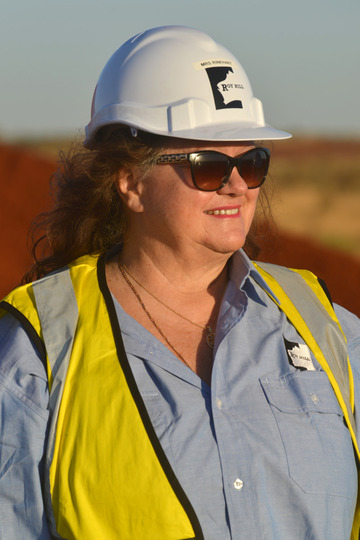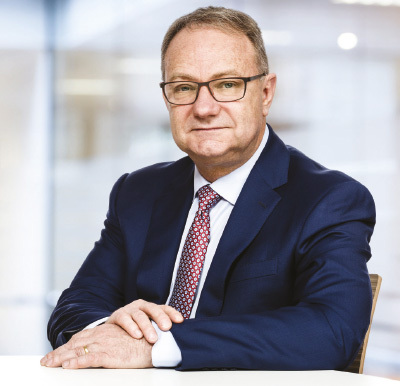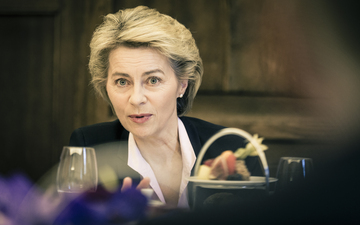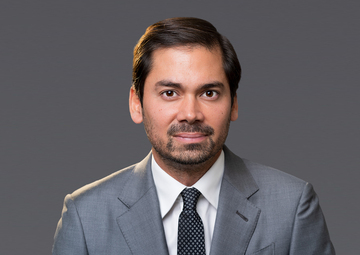1) Gina Reinhart

Last year's number 36 is our definitive number 1. Gina Rinehart has undoubtedly been one of the most influential figures in mining this year. There's not many who would plough their own cash into shares in a lithium play to make sure the resource stays within the confines of Australian borders. Who have scuppered some of the largest deals seen in the industry this year.
She divides opinion; not everyone agrees with the approach and its certainly created some nervousness around what she is planning to do with her shareholding in the space, or what she will do next. But most admire her tenacity and acumen.
And although her investment into lithium has plunged by more than A$600 million, she has more than covered that loss with profits from her iron ore Roy Hill mine. In short, the investments she's making in lithium, weren't ones she needed to make, but in doing so, she changed the course of the Australian lithium industry and buoyed the ASX.
2) Joko Widodo
With a wave of domestic popularity behind him, Indonesian President Joko Widodo has seen the country largely cast off its reputation as the ‘biggest invisible thing on the planet'.
Wielding the world's largest nickel resources and unabashed resource nationalism, Joko Widodo, popularly known as Jokowi, has led Indonesia's charge from the wings of the world's stage to a more central position.
His ambition to turn the archipelago into a global electric vehicle supply chain hub has helped drive the country's economy ahead of its peers in 2023, and the Indonesian Stock Exchange is on track for a record year.
But the reach of Jokowi's influence may have fallen short of his grand plans. Indonesia's long-running courtship of Tesla and Elon Musk remains unrequited. The country has fallen short of striking a deal to access the subsidies under the US Inflation Act. And the downstream dream still has many moving parts and complications.
And this all comes as his time as President of Indonesia - considered a high point for the country's troubled path toward democracy - is running out.
His second and final five-year term will come to an end next year. And the road ahead will be even more complicated for his successor.
3) Robert Friedland

Arguably the best storyteller in the mining industry, Mr Bombastic always has a word or two to say about the energy transition, copper's fundamental role in that, and that Ivanhoe Mines has one of the best copper mines in the world at Kamoa-Kakula in Democratic Republic of the Congo (DRC).
While some take his bombast with a pinch of salt, Ivanhoe's exploration in DRC and recent high-grade discoveries of Makoko, Kiala and Kitoko provide grist to his claim that the Western Forelands region may turn into a richer copper belt than the Chilean and Peruvian Andes.
DRC is firmly on investors map, and Ivanhoe may do the same with Angola, where it has recently begun exploration.
4) Nicola Forrest
In the small world of Western Australian mining, the news of the matrimonial split between Andrew Forrest and his wife was more than just gossip.
The split will make Nicola Forrest a major shareholder in Fortescue in her own right, independent of Andrew Forrest who will remain in place as executive chair.
This is important because it makes her a key player in an exceptionally tumultuous time for the company. There has been massive turnover in the Fortescue C-suite, as Andrew Forrest forges a leadership team that will support him in his plan to green the company, pushing toward a hydrogen-backed green steel business.
And the exceptional turnover has spread fears of a shareholder revolt. Nicola Forrest's support will now be essential if the transformation of Fortescue is going to continue.
5) Gary Nagle
While Glencore's chief executive Gary Nagle requirement for the world to "scream" for the company's copper may be overplaying its red metal development pipeline, Glencore continues to be the mining sector's master card player.
Massively profiting from thermal coal as its diversified peers fell over themselves in the rush for the exit, 2023 saw another masterstroke as a stink bid sunk Teck Resources' base metals divestment plan. Naturally, Glencore walked away with Teck's coal assets and can now undertake its own coal spin out to appease its own investors that want it to ditch coal.
6) Mark Cutifani

When Mark Cutifani announced he was stepping down as chief executive of Anglo American in 2021 there seemed little chance that the mining legend would stay in the background for long.
And in 2023 Cutifani had a dramatic return to the scene, taking charge as chair of the energy transition board at Vale Base Metals.
Cutifani chaired the business through its spin-out, attracting a huge Saudi investment in a US$3.4 billion deal, creating a new base metals giant.
7) Xi Jinping
The Chinese president led Mining Journal's most influential list in 2020 and 2021, falling outside the top 10 last year, but is back in 7th place this year.
Despite falling prices for battery metals, in an underperforming Chinese economy that has still not recovered from COVID-19, China is not backing away from using its prominent position in the metals market to assert power.
Despite this year not being the most bullish for China, there's no question about the country's importance in the critical mineral supply chain. China controls the production and processing of many minerals, such as graphite, rare earths, and gallium. Chinese overseas investments in metals and mining - and in particular minerals related to the energy transition - through the Belt and Road initiative are expected to reach a record high this year.
The US-China trade war, lasting for six years now, pressed on in 2023 with back-and-forth export bans between the countries. In July, China announced restrictions on gallium and germanium exports and in October, the country said it would tighten exports of graphite. In turn, the US restricted chip manufacturing exports to China.
China's export controls fit into larger global trends of countries taking control over their resources and supply disruptions, resulting in a boost for explorers and developers in countries perceived to contain less risk.
Yet, more recently, relations between China and the US seem to have thawed slightly, with a visit of Xi to the US, gallium and germanium exports resuming, and the prospect of a Panda loan for an American zoo.
8) Ursula von der Leyen

Europe has been getting serious about its critical minerals this year. Faced with insecurity about global supply chains and little domestic production - the EU is reliant on imports for much of its critical mineral demand - Von der Leyen has been at the head of the block's efforts to bolster its supply.
"Lithium and rare earths will soon be more important than oil and gas," Von der Leyen famously said.
The European Commission revealed its Critical Raw Materials Act in March, setting targets for domestic capacities for strategic raw materials by 2030, including at least 10% of extraction, 40% of processing, 15% of recycling, and no more than 65% dependence on any country.
Currently, the EU relies on a single country for the extraction or processing of 26 out of 54 critical materials.
In June, Von der Leyen and Argentine president Alberto Fernández signed a Critical Raw Materials agreement, boosting cooperation on raw materials between the EU and Argentina.
Negotiations are underway for a critical minerals trade agreement between the EU and the US, deciding whether minerals produced in the EU can qualify for subsidies under the US Inflation Reduction Act. The US said in July that it expects to reach a deal by the end of the year.
9) Tom Palmer
Having concluded the acquisition of Newcrest Mining in November, Newmont is now clearly the world's number one gold company with separation from fierce rival Barrick Gold. Through the purchase, chief executive Tom Palmer has opened a new frontier for the company in Western Canada, a new district in a safe jurisdiction without ceding ownership to partners.
As such, the purchase lifts Palmer out of the shade of Barrick chief executive Mark Bristow, who held sway in the early exchanges of their battle for supremacy which has dominated the gold space in the 2020s.
10) Michael Scherb

Last year Michael Scherb was not in the most Influential list. This year, the moves that Appian Capital Advisory, the private equity fund of which he is both founder and CEO, have made bold headlines. And for good reason.
This year the fund has grown exponentially. Today, it is the world's largest private equity fund in mining. To put that into context, in 2021 when Michael Scherb listed as number 35 on the Mining Journal most influential list, it raised $775 million in its second fund raise. This year, it raised $2bn and holds around $4bn worth of assets. In 2014, when a small paragraph on the bottom of an article on PE raises came out in Mining Journal, the fund had raised $375 million. But it isn't just about the amount raised but also the influence exerted over the market in general. ""What we've done is we've proven our ability to find projects, build them and then sell them. We've built nine mines and production in the last six or seven years," Scherb told Mining Journal in June this year.
New entries
A strong new entrance this year was the Indonesian president Joko Widodo, at number 2. But anyone surprised at the sudden entrance of this politician, little known to the mining world until recently, has not been paying attention to copper and nickel markets. Jokowi's high ranking in the list is a reflection of the fact that Indonesia has demonstrated how rapidly critical minerals expansion can be enacted. The next challenge will be how to do it without relying on Chinese investment.
Ursula von der Leyen is another strong performer, reflecting that fact that leaders and legislators are finally starting to get their heads round the critical minerals challenge facing the world. Let's hope that more politicians try to make the list next year.
An interesting move this year is Heather Gamble, who is a new member on the list at number 49. CEO of Women on the Move: Artemis Project Canada, Gamble's ambition is to disrupt the mining industry and create the world's first woman-owned and operated mine. The Artemis project is a social enterprise founded on a collective of female entrepreneurs working with the mining industry. One of the programmes it has run was in the sponsorship of Chilean mining engineer graduates to Canada, where there is a need for younger and more diversified talent.
Diversity, up to a point
Our yearly Most Influential list often gets slammed on social media for being too male. But we can only reflect the industry as it exists. Fortunately for our mentions, 2023 was a year when women made waves in the industry, led by Gina Rinehart, who is ploughing money into lithium at a time when others are backing away.
The geographic spread of companies mentioned, at least based on where their headquarters are located, remains more limited, with North America, Australia, and Europe continuing to see most head offices.
Meanwhile, government officials have a bigger role than ever before, even as finance backs away, perhaps a sign of where miners should be looking for funding next year.

























